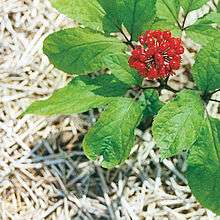Panax ginseng
Panax ginseng, the ginseng,[2] also known as Asian ginseng,[2][3] Chinese ginseng,[2][3] or Korean ginseng,[2][3][4] is a species of plant whose root is the original source of ginseng. It is a perennial plant that grows in the mountains of East Asia.
| Panax ginseng | |
|---|---|
 | |
| Scientific classification | |
| Kingdom: | |
| (unranked): | |
| (unranked): | |
| (unranked): | |
| Order: | |
| Family: | |
| Genus: | |
| Species: | Panax ginseng |
| Synonyms | |
Names
Panax ginseng is called Rénshēn (人蔘 or 人参 or 人參; lit. 'ginseng') in Chinese, Insam (인삼; 人蔘) in Korean and Ninjin (人参) in Japanese.
Folk medicine
Ginseng is used as an herb in folk medicine.[3]
Distribution
Panax ginseng is native to mountainous regions of Russian Far East (Outer Manchuria), Northeast China, and the Korean Peninsula.[2] It is a protected plant in Russia and China, and most commercial ginseng is now sourced from plants cultivated in China, Korea and Russia. The plant is a slow-growing perennial and the roots are usually harvested when the plants are five or six years old.[5]
Cultivation
Panax ginseng is one of the most commonly cultivated ginseng species, along with P. notoginseng (grown naturally in China), P. ginseng (grown naturally in China, North Korea and South Korea), and P. quinquefolius.[6]
See also
| Wikispecies has information related to Panax ginseng |
| Wikimedia Commons has media related to Panax ginseng. |
References
- Synonyms in Catalogue of life
- "Panoch ginseng". Germplasm Resources Information Network (GRIN). Agricultural Research Service (ARS), United States Department of Agriculture (USDA). Retrieved 13 February 2018.
- "Asian Ginseng". National Center for Complementary and Integrative Health (NCCIH). September 2016. Retrieved June 24, 2017.
- English Names for Korean Native Plants (PDF). Pocheon: Korea National Arboretum. 2015. p. 559. ISBN 978-89-97450-98-5. Archived from the original (PDF) on 25 May 2017. Retrieved 24 December 2016 – via Korea Forest Service.
- Mahady, Gail B.; Fong, Harry H.S.; Farnsworth, N.R. (2001). Botanical Dietary Supplements. CRC Press. pp. 207–215. ISBN 978-90-265-1855-3.
- Baeg, In-Ho; So, Seung-Ho (2013). "The world ginseng market and the ginseng". Journal of Ginseng Research. 37 (1): 1–7. doi:10.5142/jgr.2013.37.1. PMC 3659626. PMID 23717152. Retrieved 11 August 2018.